|
|||||||||||||||||||||||||||||||||||||||||||||
Freshwater Molluscan Shells / Corbiculidae
The Corbiculidae are a widespread family of moderate sized clams, often tinged or colored with violet on the interior. The name "corbicula" (little basket, from corbus, basket) refers to their characteristic concentrically ribbed shells and general shape. They are ovoviviparous, brooding internally fertilized eggs in brood pouches. Brood size is large, but the juveniles released into the surroundings are tiny, in contrast to the related sphaeriids. Individuals of Corbicula fluminea (Muller) are unusual in producing only eggs at earliest maturity, followed later by sperm. They then become simultaneously hermaphroditic and remain so throughout their lives (McMahon, 1991). There are twelve genera listed by Banarescu (1990), including several characteristic of brackish waters, and the additional genus Posostrea recently described by Bogan and Bouchet (1998).
Corbicula; central and southern Africa, Central and southern Asia.
Geloina; southern Asia and Malaysia.
Cyrenodonax; southern China, Viet Nam.
Cyrenobatissa; northern Viet Nam.
Batissa; Malaysia and Indonesia.
Posostrea; Lake Poso, Indonesia
Corbiculina; eastern Australia.
Solielletia; Ethiopia.
Polymesoda; Gulf coast, and Atlantic coast of northern South America.
Neocorbicula; Gulf coast, and Atlantic coast of northern South America.
Pseudocyrena; Caribbean side of Central America.
Egetaria; Atlantic coast of South America.
Villorita; eastern parts of South America.
Asia (invasive in North America and elsewhere)
a.
b.
There are at least two varieties of Corbicula, the "Asiatic clam" now present in eastern North America, often referred to collectively as C. fluminea (Müller, 1774), C. fluminalis (Müller, 1774), C. manilensis (Philippi, 1844), or C. leana (Prime, 1864).In eastern North America, form "a" is more widespread, occurring in all habitats from small creeks to large reservoirs, while form "b" seems restricted to certain large reservoirs at this time, where populations may contain both forms in differing proportions. Their morphological differences are consistant, allowing a set of specimens to be sorted with little ambiguity. The specimen on the right, "b", is more inflated, with higher umbones, a relatively thicker shell, and the lateral teeth are thicker and set at about 90° to each other, sometimes less. The more common variety "a" is less inflated, with lower umbones, and always has the lateral teeth set at an obtuse angle. The varieties may correspond to the "purple" and "white" forms of Hillis and Patton, (1982), although there is much less difference in shell color in these specimens from Chickamauga Reservoir in Tennessee. Unfortunately Hillis and Patton did not illustrate their material. They recommended against applying specific names to either variety until the systematics for these species are worked out in their home ranges.
Zhadin, (1952) includes drawings of two species native to the Soviet Union, exterior only. One, a wider, larger shell , C. fluminea, var. suifunensis, roughly resembles the variety "a" shown above. It is native to the coastal areas of eastern and southeastern Asia. His C. fluminalis, native to central Asia, is a narrower more triangular shell that resembes variety "b".
McMahon, (1991) figures a widespread "light" form, while the "dark" form is limited to spring-fed carbonate-rich streams in the Southwestern United States. He assigns the light form to C. fluminea (similar to variety "b"), but not in agreement with Zhadin, and leaves the dark form unidentified (Corbicula sp). It is likel therefore that there are more than two species of Corbicula in North America. It also appears possible from the shell descriptions given by McMahon, that his "dark" form could be an ecophenotypic variant of variety "a".
Corbicula are also present in the Columbia River of western North America. The few specimens available to me show an intermediate outline, with thinner lateral teeth like variety "a".
Corbicula that appear to be of asiatic origin are also in:
Lower Colorado River, Nevada and
California, USA. Very small, relatively
thick shells.Guayaquil, Ecuador, on the Pacific coast of South America. Willamette River at Portland, Oregon, with an
intermediate outline, but thinner lateral teeth like
variety "a".Arkansas River near Hutchinson,
Kansas, also an intermediate form.
Small, relatively thin shells from Mol, Belgium.
Periostracum color is not particularly diagnostic, as in most locations small young ones are greenish yellow, and they slowly darken as a function of age and water chemistry.
Packaged Corbicula clams can now be found in the frozen foods sections of larger Asian groceries throughout the United States.
These are labeled as "small shell clams" and a product of China. There is also a "baby clam" size available, product of Vietnam. Packages were $2.79 for the 340 g "12 oz." larger shell size and $3.89 for a 400 g "14 oz." package of "baby" clams.
Listed nutrition facts:
71 Calories, 1.7 g total fat, 0 g saturated fat, 0 g trans fat 146 mg cholesterol, 1770.5 mg sodium, 8.9 gtotal carb, 0 g dietary fiber, 0 g
sugars, 4.8 g protein, 10% dv vitamin C, 39% dv calcium, and 11.4% dv iron. The high sodium suggests the addition of salt, even
though it is not shown as an ingredient.I would suggest that with the advent of widespread air travel, Asiatic peoples have brought these clams from their homelands to almost every part of the world they have settled.
Corbicula sandai Reinbardt, 1878. Japan. Corbicula baudoni (Morieti,
1886), Mekong River.
Three species are listed as occurring in China by Liu Yueyin (1979) Economic Fauna of China (Freshwater Mollusks); pictures included below for reference.
Corbicula fluminea
(Müller, 1774)Corbicula largillierti
(Philippi)Corbicula nitens
(Philippi)Liu Yueyin lists 52 synonyms for C. fluminea, 3 for C. largillierti, and 6 for C. nitens. With Corbicula, as with so many other freshwater mollusks, superfluous species names abound.
Southeast Asia and East Indies
Brandt (1974) figures 26 Corbicula species for the territory of Thailand, most varying from each other in relatively minor ways. These include the species C. fluminea, C. baudoni, and C. largillierti mentioned above, of which C. largillierti and C. baudoni are listed as synonyms. He also figures one Batissa and three Polymesoda species for Thailand, similar to those shown below.
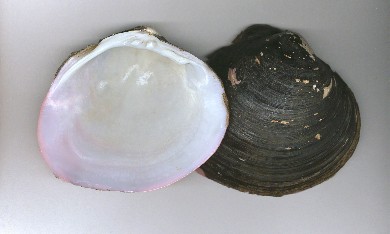
Batissa violacea Lamarck, 1806, Indonesia.
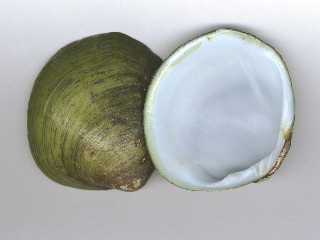
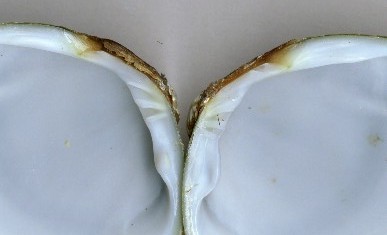
Polymesoda sp., Philippines, and detail of the hinge teeth. Conspicuous projections on both laterals on the right valve fit into
corresponding depressions in the left. This arrangement is similar to the Sphaeriacea (fingernail clams) of temperate waters.
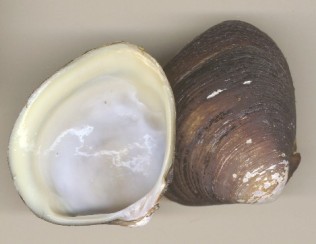
Cyrenobatissa subsulcata (or Cyrenobatissa maxima), Chinese name is“Da Xian".
Bogan and Bouchet (1998) describe the corbiculid species Posostrea anomioides endemic to Lake Poso on the island of Sulawesi, Indonesia, where it lives attached to the undersides of blocks of limestone or other localities sheltered from direct sunlight. Unusually for cementing bivalves, this species attaches by either valve with equal frequency.
Posostrea anomioides Bogan and Bouchet, 1998 in habitat.
Photo courtesy Art Bogan. Actual size approx. 15 mm.
South America
Neocorbicula limosa Maton, 1809. Uruguay, two specimens, x 2. Shells are substantially less inflated than
Asian species.
"Neocorbicula limosa" Maton, 1809.
Uruguay, from another source, more likely
another Asian escapee. 2x magnificationNeocorbicula brasiliana Deshayes, 1854
Brazil. The ribbing is much finer on these very small
shells, here shown at 4 x magnification. Maybe hybrid?
North America (native)
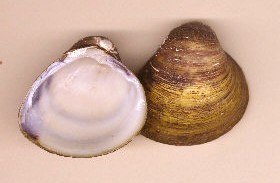
Polymesoda caroliniana (Bosc, 1801) Carolina marsh clam.
Tidally influenced brackish and fresh waters, coastal marshes and creeks, southeastern North America.
Africa
Pilsbry and Becquaert (1927) quote an earlier author (Connoly) that "it would require intimate acquaintance with the types and long sets of each variety to unravel the extraordinary tangle into which the African species of Corbicula have been woven"
They include only 4 species in their descriptions, plus one additional subspecies, including the widespread C. fluminalis. In addition, they list two species of Soleilletia from the work of Bourguignat.
Corbicula radiata (Philippi, 1846)
Nile river and elsewhere.